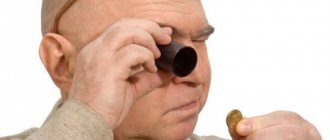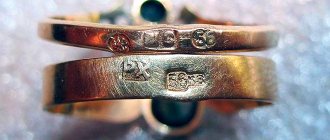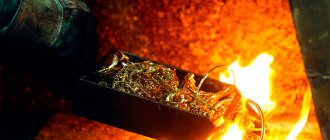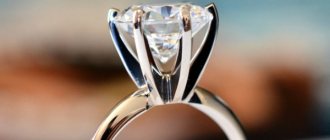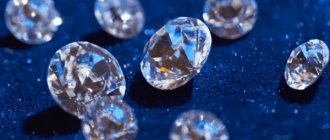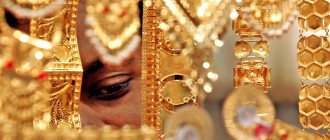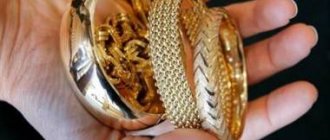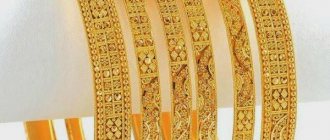Gold jewelry is in great demand all over the world. The jewelry market is growing rapidly, while gold production, on the contrary, is falling from year to year. Nowadays, the desire to get rich forces people to cheat. Most of the items in jewelry stores are actually an alloy of metals. Not the whole thing may be sent to inspection services for examination, but only a part made of real gold. For example, it could be a clasp or a lock. In addition, they only check the top layer; what’s inside remains unknown. Even the highest quality gold jewelry contains impurities that occupy a smaller part, because the metal itself is very soft and wears off quickly. To avoid being deceived by scammers, you need to know how to test gold at home.
Look at the sample
Factory products always have a standard stamp with a hallmark. Fineness is the number of grams of pure metal in the alloy; the lower it is, the worse the quality.
According to Decree of the Government of the Russian Federation dated May 6, 2021 No. 394, all alloys in which more than 30% of the weight is precious metal must be stamped with hallmark. Standard samples for gold are 375 (lowest), 500, 583, 585, 750, 916, 958, 999 (highest - only 1 g of impurities per 1 kg of metal).
In the USA and Canada, carat hallmarks are used (9 carats correspond to the 375th hallmark, 24 carats correspond to the 999th). Moreover, the letter K next to the numbers means that the product itself is gold, and KGP means that it is plated with gold (karat gold plated).
In Belgium, gold samples are designated by numbers: 1 – 833, 2 – 750, 3 – 585. A similar system works in the Czech Republic and Slovakia: 0 – 999, 1 – 986, 2 – 900, 3 – 750, 4 – 585.
Examining a sample is often difficult. Use your smartphone in macro mode, then enlarge the photo and look at the sample in detail. The mark should not be crooked or blurry. This is, if you like, a passport of the product, so they are very careful when applying it.
Alloys of gold products
Gold, due to its chemical properties, is a precious and soft metal, and if you do not add other components to it, it will not hold its shape.
In certain proportions they can add:
- platinum,
- silver,
- bronze,
- brass,
- steel.
A sample is placed on gold jewelry, which shows the proportion of gold in the product in relation to other metals. The standard is considered to be 999 gold purity, that is, pure gold.
In the finished jewelry, the maximum proportion of gold is 75 percent, and 25 percent is admixtures of other metals, that is, 750 standard.
For mass sale of gold jewelry, 585 and 375 samples are made. Gold products with 375 samples are made with a lower gold content, usually watches, antiques, and the price of products from such an alloy is lower than those made from 585 gold.
Attach a magnet
Plating steel or other alloys with a high iron content with gold or its imitation is a common practice. Only ferromagnets are strongly magnetic - iron, cobalt, nickel, gadolinium, terbium, dysprosium, holmium, erbium, thulium.
Dimagnets (for example, water or table salt) and paramagnets (aluminum, etc.) are weakly magnetic. All non-ferrous metal is not magnetic.
If it happens on the beach or in places where tourists gather, buy the cheapest magnet in a souvenir shop and attach it to the product. If it sticks, it’s definitely a fake or the metal is of too low standard (too many iron impurities). If not, perform other checks.
How to clean a product from iodine stains?
Some more questions arise later, after checking for authenticity. Of particular interest is the question of how to purify gold from iodine? The fact is that iodine leaves traces on the product in the form of dark spots. The size of the spot depends on the amount of iodine applied during testing. But getting rid of them is not difficult, but you will definitely be sure that you are holding real gold in your hands and not other alloys.
An iodine stain will disappear on its own over time, especially if it is small, but sometimes it needs to be erased faster. To do this, there are several methods that allow you to remove stains on gold and clean the product as a whole:
- Weak solutions with powder or soap will not help, since the stain is quite resistant to them.
- Use hyposulfite as a cleaner. This substance, which is used when developing photographs using the old method, is also called a fixer. Method for preparing the solution: 1 tablespoon of fixative per glass of warm water. The product should be kept in the solution for half an hour, after which it should be rinsed under water and dried.
- A solution with ammonia can also get rid of the problem. But keep in mind that the method may not always work, and besides, the smell of ammonia will disappear within three days. Therefore, this technique will not help solve the question of how to purify gold from iodine in a short time.
- The oldest cleaning method is to mix 80 grams of lime with 70 grams of soda and 20 grams of salt. This powder is diluted in 1 liter of warm water; the decoration should be kept in the solution for about an hour and a half.
Testing gold with iodine is only suitable if the product is made of a solid metal alloy. If the jewelry is gilded, then the test will also be positive if you do not completely erase the gilding layer. Or you may simply damage the product, after which you will have to order a repeat gilding procedure from the jeweler. Therefore, before checking, look at the product tag or do not take risks, but simply take the ring to the master.
It is best to carry out the cleaning procedure at a jeweler. You can also carry out the verification procedure there. Of course, home methods are cheaper, but they are more labor-intensive and unreliable.
If you want to confirm the authenticity of gold in a product, you should contact a jewelry workshop and ask to determine the type of metal and even the fineness of the alloy. This can be resolved in a few minutes. Previously, cuts and cuts were made on the wrong side of the product. But now the devices determine all indicators without interfering with the integrity of the product. This is done by determining the density of the metal and chemical reactions. After completing the procedure, you will receive a document confirming the presence or absence of gold in the product.
Test with vinegar
Tell the seller that you will test the gold with vinegar. Are you nervous? There’s no need to run to the grocery store anymore. But a professional who is confident in his product will not sweat it.
Fake gold quickly darkens in vinegar - just pour a little into a glass and hold the metal in it for about five minutes. But real high-grade metal doesn’t care about anything.
Precious metal detectors
Devices for checking the authenticity of precious metals make it possible to determine both their quality and the reliability of the sample supplied. There are several types of such equipment. These are digital and electrochemical detectors, as well as spectral analysis devices. Their task is to quickly and accurately determine the percentage of gold in the alloy.
The indicator is expressed in carats. The devices make it possible to detect counterfeits both by composition and by the presence of coatings on the jewelry.
Drop some iodine
Rub the product on jeans or other thick fabric, then drop iodine on this place on the metal. High standard gold does not darken. If the metal has darkened (this may appear within a minute), the product is not genuine or the standard is not too high.
But brass and copper do not change color from iodine either. So this testing method is good for high-grade gold, but it is not enough on its own.
We do not recommend testing products with iodine levels of 585 or lower. After iodine, you will definitely have to polish them or remove stains with ammonia; traces may remain.
How to determine the gold standard yourself?
Gold is mixed with other metals to give the jewelry strength, because on its own it is too soft and the jewelry will not be strong enough. Alloys are sometimes created in order to diversify the color range of the range of products - the result is jewelry with pink, reddish and even greenish hues.
You need to understand! The test shows the ratio of precious metal with impurities in the jewelry; this is a three-digit number stamped on the surface of the product. In Russia, the 585 standard is common, and others have also been established: 375, 500, 583 750, 950, 999. The number 585 means that the product contains 58.5% gold, everything else is an admixture of other metals. The deception in the production of jewelry lies in the lower gold content than required by the carved sample.
How to determine the gold standard at home?
After testing the product for authenticity, you can check how much gold is present in it, that is, find out its fineness. This can be found out in the following ways:
- drop method using a chemical reagent;
- a special device;
- assay analysis.
Drip method
The difficulty of using this method to carry out it at home lies in the lack of necessary experience to complete the process. In addition, you need to purchase chemical reagents, but they are usually available and sold in specialized jewelry stores . Moreover, the method is recognized as one of the most reliable.
Various types of reagents are used to determine the sample:
- acidic;
- chlorine gold (for 585 standard);
- potassium iodide.
The reagent is applied to a small surface cleaned with a file. After waiting about a few seconds, you will need to evaluate the change in the color of the gold.
- 585 sample - light brown color;
- 375 standard - green color.
The darker the remaining color, the lower the grade.
Determination by device
An electronic detector allows you to quickly and accurately determine the gold standard at home . The device can easily distinguish where the gold-plated fake is and where the genuine product is, giving out the exact gold content in it. The data will be shown in carats, which will allow you to calculate the sample number.
✅ RECOMMENDED: Is it possible and how to return money for low-quality or defective goods
It makes sense to buy a device for those who regularly deal with gold jewelry. Otherwise, it’s easier to go to a jewelry store or pawnshop.
Determination with assay needle and touchstone
An assay needle is a pointed rod with a thin needle made of an alloy of precious metals. The sample is determined on a polished black beam made of fine-grained slate - a touchstone.
Procedure on the surface of the stone:
- clean it with wood water and charcoal;
- lubricate with oil and wipe dry;
- draw a line with a piece of jewelry;
- draw a needle next to this line;
- examine and compare the colors of the marks left behind.
The line from the needle will show the reference color.
The test is also carried out using nitric acid. Using the cleaned area of the product, you need to create a “rubbing” - rub the stone so that metal particles remain. The trace of the fake will evaporate under the action of acid, but the traces of genuine gold will remain in place. Only jewelers in a pawn shop or workshop can accurately determine the sample number.
Features of testing white gold
One of the favorite varieties of precious metal connoisseurs is 585-carat white gold. Silver can be passed off as noble white gold; scammers actively take advantage of the external similarity of these metals. Only a professional will see the differences, and there are many of them - in color, shades, hardness, stamp design and even sound.
The well-known “Whiteness” tool will allow you to check the authenticity of white gold using available means and distinguish it from silver. A drop of the product will not leave a mark on white gold, but a black spot will form on silver. In the same way, you can check the product with iodine - only silver will be stained.
Draw with lapis pencil
A lapis pencil is needed to stop the bleeding. This is an antiseptic based on silver nitrate, it can be bought at a pharmacy, it costs about 100-150 rubles.
To check the authenticity of gold, soak the item in water. Then, using a lapis pencil, draw a small line over the wet one and wipe it off.
Lapis does not react with gold, but does react with other metals. If a trace remains, then the gold is fake or of very low standard. Nothing will happen to genuine metal.
Alloys
Gold jewelry comes in different colors. It depends on the combination of impurities in it.
- White White is highly valued in the jewelry market. This metal is very durable. Silver and platinum give it a white tint.
- Pink Today it is considered classic. The pink color comes from copper and silver added in equal proportions.
- Yellow There are 2 shades: light yellow and orange yellow. If the product is orange-yellow, it is an alloy of gold and copper. It is made lighter by adding silver.
- Green Due to its increased fragility, it is used only for creating various decorative items. The metal acquires this unusual shade as a result of the addition of silver, copper or cadmium.
- Black We started producing it quite recently. Black color is obtained by adding cobalt and chromium to the metal. And you can also change the color through laser processing and applying a special coating.
- Blue Obtained by mixing silver and steel in equal quantities.
- Red Red gold is considered to be of the best quality. When heated, the metal acquires a red tint. It contains a minimal percentage of impurities, which is why the products are quite soft. For this reason they are created massive.
- Purple Obtained by adding a small amount of aluminum. Like green, due to the increased fragility of the metal, it is used more often to create decorative jewelry.
It is not difficult to check the authenticity of gold at home, but it is worth using them if it is not possible to contact a specialist. You should not purchase goods from suspicious persons and unregistered retail outlets. When purchasing, carefully examine the product. The inside of a quality product must be made carefully. The price tag must indicate the weight and purity. Choose jewelry in stores that have been tested by quality and time-tested manufacturers.
Test with black bread
The method is safe (for real gold!), but slow. Take the crumb of black bread, remember, mix with water and stick the mixture onto the product. Leave it until the bread crumb turns into a dry crust, then break it apart.
If there are dark traces inside the crumb, it means the fake has oxidized. If not, then it is either gold or good gilding.
Instructions
Probably everyone has such a drug as iodine at home. If not, then it can easily be purchased at a pharmacy, since it does not require a doctor's prescription and is cheap. In medicine, iodine is considered an antiseptic. However, it is also used for other purposes. For example, a widely known method for testing gold is iodine, where it is used as an indicator to determine the authenticity of the metal. However, the drug will only help in recognizing gold. For other metal products it will not show the true result. So, having decided to try this method, you need to do the following.
- They take gold jewelry. Usually, doubts arise in samples 583 and 585, since their tint may be slightly reddish, which can raise doubts. But it may also be associated with the presence of an alloy in the metal composition.
- Then the product is lightly sanded on the inside. This is necessary for the reaction with iodine to occur. Most often, sandpaper is used for this, although you can use another abrasive.
- After soaking a cotton swab in iodine, apply it to the gold item in the place of wear. It doesn’t matter whether a small or large amount of iodine will participate in the reaction. Therefore, you need to try to apply only a small, unnoticeable spot. The reaction will not increase depending on the size of the abrasion area, but then you will have to spend more effort to wash it, and a trace of abrasion may remain.
- It remains to monitor the reaction. If a dark color stain appears, then the jewelry is genuine. It is precisely made of precious metal. But if the color remains the same, then the product is not gold, but bronze, copper or brass. The chemical reaction occurs because gold is able to react with halogens. And iodine is exactly that.
Don't try it on your teeth!
Gold is a soft metal, so if you squeeze it hard with your teeth, marks will appear. Agree, the seller will not like it and will force you to buy.
Athletes test their medals for the sake of photos. Moreover, gold medals are actually just gold plated.
By the way, fake aluminum behaves exactly the same way, so if the seller insists on a “teeth test”, don’t be fooled.
On the other hand, only a new product does not have even small scratches on the surface. If a person claims to be selling his used gold, but it appears to have only come from a factory, something is wrong here.
How to check 585 gold for authenticity in a store: obvious signs
Black market craftsmen have learned to make fake jewelry quite professionally. As a result, upon external examination, it can be difficult to distinguish a fake from an original, especially if a person does not deal with jewelry very often. But there are some criteria, based on which it is still possible to identify gross plagiarism and not lose money.
So, how can you check the authenticity of gold in a store, since the sellers there do not allow radical manipulations with the product?
It is necessary to concentrate on the obvious signs that distinguish the original from the forgery:
- Appearance. The standard product is finished extremely carefully and in detail. Each element is made without defects, and the fastening mechanism (for example, if a necklace or bracelet is considered) is characterized by strength and reliability. Any flaws (chips, cracks) on the front or back side of the product are a reason to doubt that it is genuine. In addition, the original gold accessory has a characteristic pleasant shade. Excessive redness, yellowness or strange pallor of the alloy is a bad sign, raising the suspicion that the composition contains too much impurity of cheap metal (lead, copper, etc.).
- Availability of sample. Each original product must have an appropriate mark, and it must be clear and clearly visible. It is difficult to see the markings on antiques alone. Alas, scammers have gotten used to imitating it, which also needs to be remembered.
- Availability of a certificate. The label and accompanying documentation are also attributes of a quality product. The label certainly contains accurate data about the item itself (weight, name, etc.), as well as the name of the manufacturing plant.
- Physical properties. The type of metal is determined by the sound it makes when it falls on a hard surface (table, counter). Pure gold rings like crystal. If you rub the product with your fingers for several minutes, then in the case of a fake, the leather will smell the same as it would smell after contact with construction nails. The hardness of the alloy (gold is a soft metal) is tested with teeth, but such a procedure is unlikely to be carried out by a store employee.
conclusions
If you buy gold secondhand or from an unverified store, use as many methods as possible to ensure the authenticity of the product. The main thing is not to try too hard, so as not to spoil the soft metal.
(
61 votes, overall rating: 4.36 out of 5)
